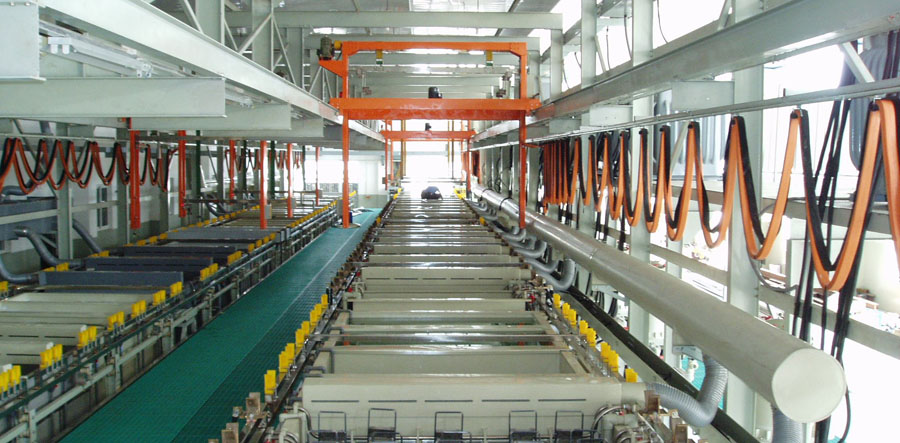Plating in CNC machining refers to the process of applying a thin layer of metal coating onto a machined part’s surface through electroplating or electroless plating methods. This plating serves various purposes, including enhancing the part’s appearance, improving corrosion resistance, increasing hardness, and providing better conductivity or solderability.
In this blog, I will take you to understand what plating is actually, why you may choose plating as the precision machining process for the next CNC machining project, the factors that affect the final plating precision machining, and how to allow for it during the design phase.
What Is Plating?
Plating is a common finish used for CNC machined components, a surface covering process where a thin layer of metal is added after machining.
While much plating is done for decorative purposes, still more is done to increase the durability and corrosion-resistance of softer materials. Most automotive parts, appliances, housewares and flatware, hardware, plumbing and electronic equipment, wire goods, aircraft and aerospace products, and machine tools are plated for durability.
Types of Plating
Electroplating:
Involves immersing the part in an electrolyte solution containing metal ions, such as nickel, chrome, zinc, or gold. An electrical current is passed through the solution, causing the metal ions to deposit onto the part’s surface.
Electroless Plating:
Unlike electroplating, electroless plating does not require an external electrical current. Instead, it relies on chemical reactions to deposit metal coatings onto the part’s surface. Common metals used in electroless plating include nickel, copper, and gold.
Benefits Of Plating In CNC Machining
Enhanced Appearance:
Plating can improve the aesthetics of machined parts by providing a smooth, uniform, and lustrous surface finish.
Corrosion Resistance:
Plating with corrosion-resistant metals like nickel or chromium can protect parts from rust and corrosion, extending their lifespan in harsh environments.
Wear Resistance:
Certain plated coatings, such as hard chrome or electroless nickel, can increase the part’s resistance to wear and abrasion,protecting components from environmental factors and extending their lifespan.
Electrical Conductivity:
Plating with metals like gold or silver can enhance the part’s electrical conductivity, making it suitable for electronic applications.
Solderability:
Plating with metals like tin or lead can improve solderability, making it easier to solder electronic components onto the part’s surface.

Plating Process:
Preparation:
Before plating, the machined part must undergo thorough cleaning and surface preparation to remove any contaminants, oils, or oxides that could interfere with the plating process.
Plating Bath:
The part is immersed in a plating bath containing the desired metal ions or chemicals. An electrical current may be applied to the bath during electroplating to facilitate metal deposition.
Deposition:
Metal ions in the plating bath adhere to the part’s surface, forming a thin, uniform coating through electrochemical or chemical deposition processes.
Post-Treatment:
After plating, the part may undergo additional treatments such as rinsing, drying, or passivation to improve adhesion, durability, and surface properties.
Why Is Plating A Specialist Process?
People generally believe that plating and precision machining methods are similar. The reality is that it requires a very unique set of skills. Plating requires a unique combination of process and technical expertise to carefully manage multiple variables and control factors.
So if you need plating for your part, we have professional cooperative factory to do this for you, they have rich experience for plating and then we do the final inspection for the parts.
The final plating finish is dependent on the following factors:
The Electrolyte Nature That Is Used In The Process
The Density Of The Deposition
The grade and source of the component’s raw material
The geometric shape of the component
How the component is held, supported, and fixed through the plating process
Where the item is positioned within the processing vessel
How the component is orientated throughout the process
The other components that are processed within the same batch
The Temperature At Which The Process Takes Place
The skill and experience of the individual performing the process
Plating Tips For Designers
Consider plating process requirements during the draft design phase. Collaborate with capable plating companies or one-stop processing service providers to understand any potential processing issues and reach an agreement on how to plan consistent plating in design
- Indicate on the drawing whether the surface treatment dimensions are before or after plating
- Larger plated components may require two dedicated blind threaded holes at each end of the component to ensure good electrical connection and eliminate any opportunities for arcing and damage
- For plated components, only specify strict tolerances when necessary
- Discuss the plating margin (growth of each surface during the plating process) with the plating company and mechanic. Include machining notes on the drawing
- As tolerances become increasingly stringent, components need to be processed in separate batches rather than being mixed with other different parts
- In cases where tolerances are crucial, post plating grinding and honing may be necessary to ensure consistent results.
- Unless necessary, do not specify threads with grade fits. There are multiple tolerances for interaction when assembling screws and nuts
- If aesthetics are important, please add notes on the drawing
- Carefully select an plating company that typically handles such work as a partner
At SANS Machining, we collaborate with a carefully selected network of plating and coating suppliers. All parts must comply with our strict quality procedures and undergo a comprehensive inspection before shipment to ensure that we deliver high-quality finished components time and time again.



